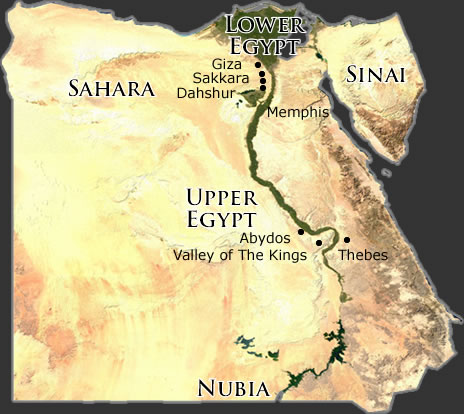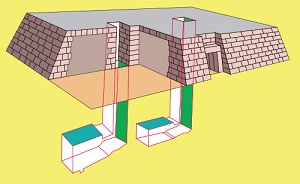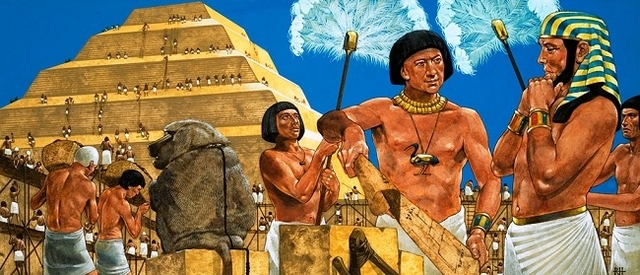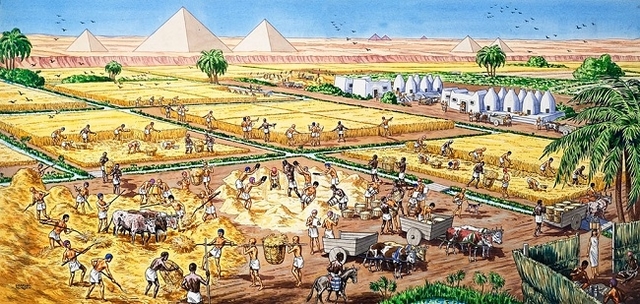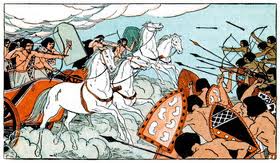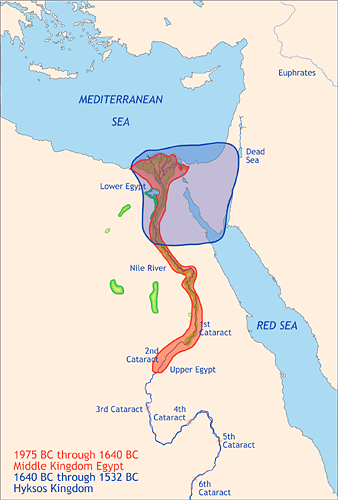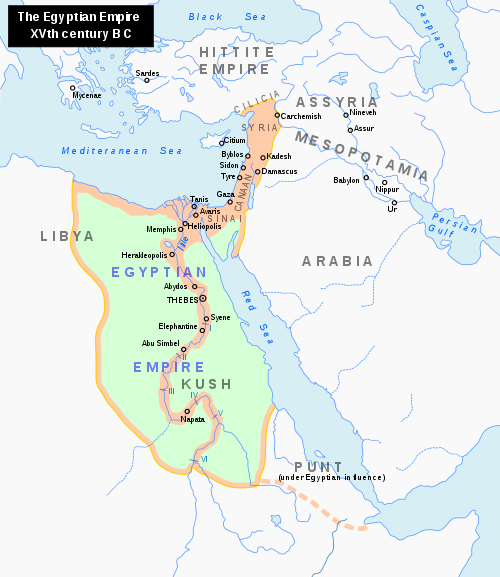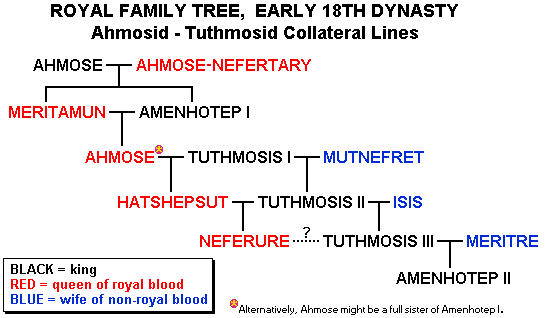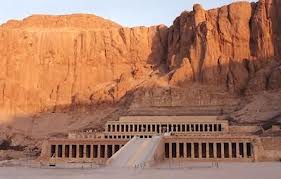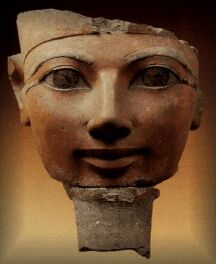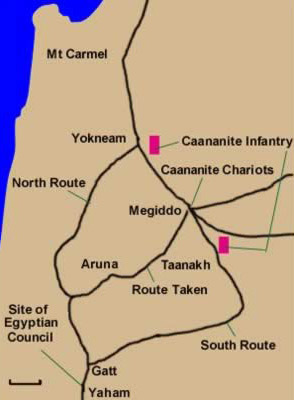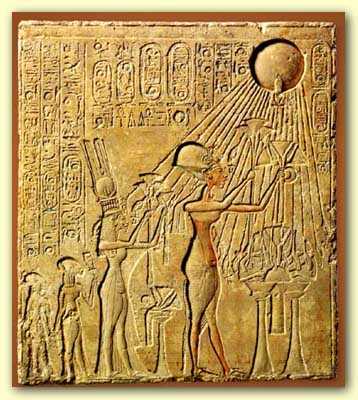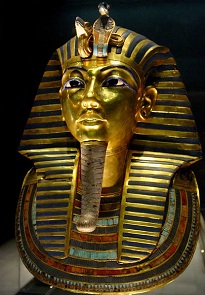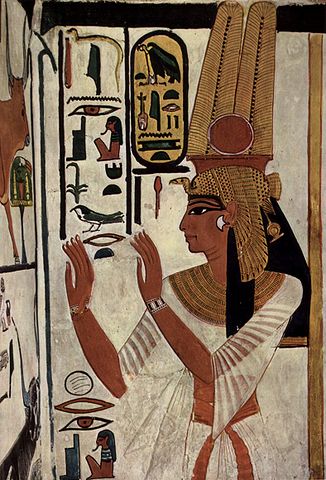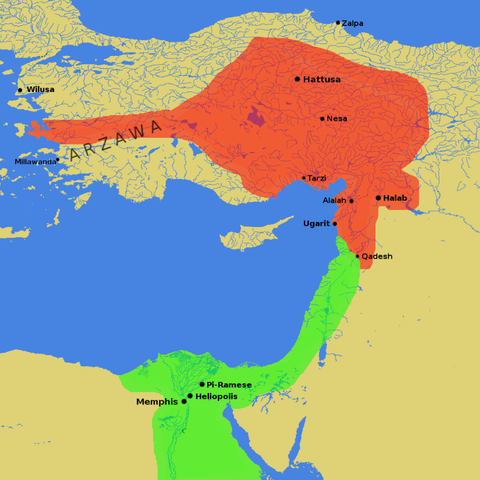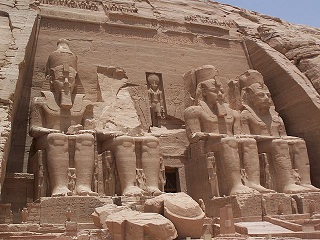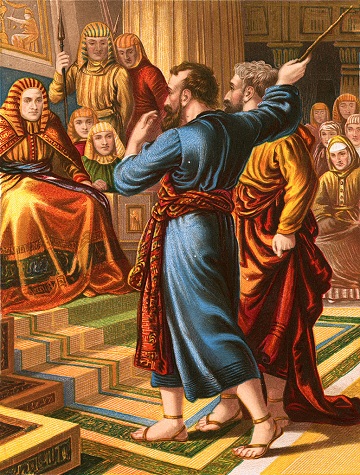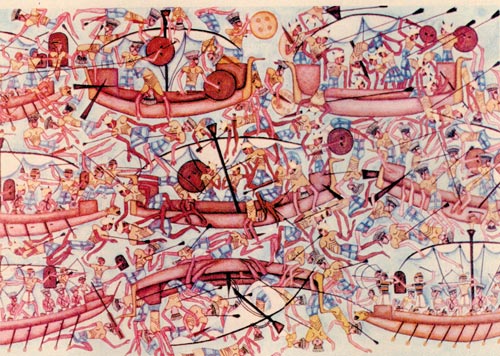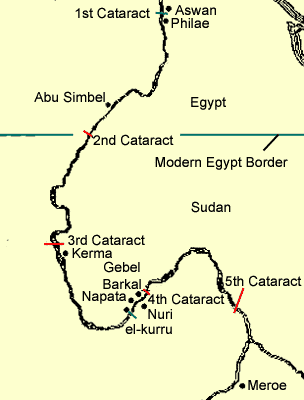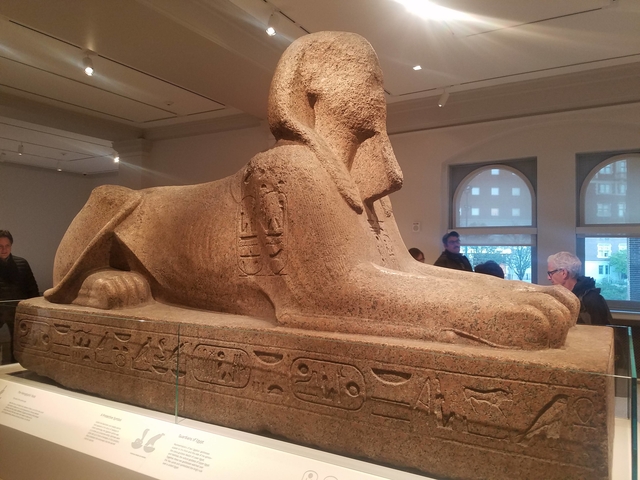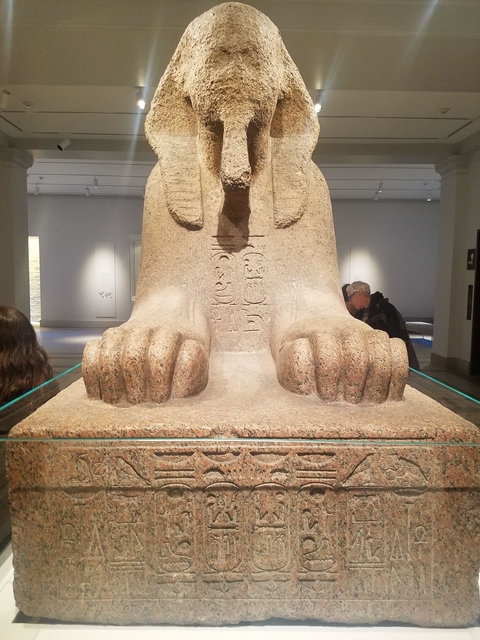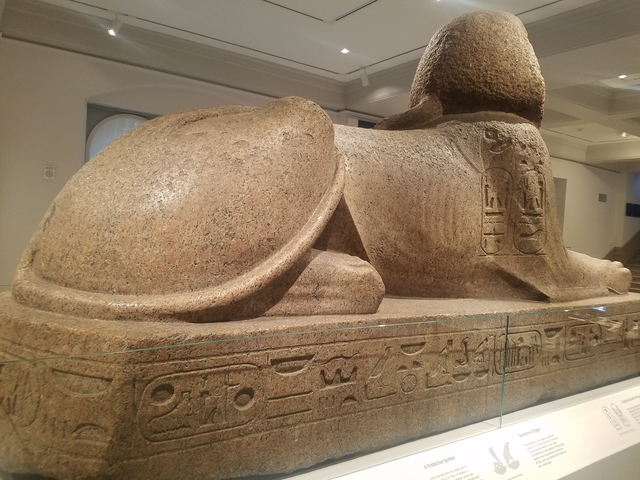
| ANCIENT EGYPT Ancient Egypt - the Archaic Period and Old Kingdom :
Egypt is one of the oldest countries in the world. Mesopotamia was a region separated into independent city-states. Mesopotamia was only united by warfare as an empire. The people of Egypt were united, and accepted the rule of one person, called pharaoh. Pharaoh is a Greek word that means "great house."
Herodotus, an ancient Greek historian, visited Egypt and called it, "The Gift of the Nile." Without the Nile and its annual flooding, which deposited silt on the banks of the river, Egypt would be nothing more than a desert, unable to maintain a civilization.
The Archaic Period (3100-2649 BC) :
Upper and Lower Egypt During the earliest history of Egypt, called the Archaic Period, Egypt was separated into two lands: Upper and Lower Egypt, each with its own king. This can be confusing when we look at a map, because Lower Egypt is at the top of the map, while Upper Egypt is at the bottom. This is because the Nile River flows from the high land in the south to the low land in the north. The Nile is one of the few rivers to flow north, the other that comes to mind is our own Genesee River.
We have very few records from the Archaic period, but one account tells of a king of Upper Egypt named Menes. Menes sent an army down the Nile and defeated the king of Lower Egypt in battle. In this way Menes united the two kingdoms. Unification means the joining together of two separate parts, in the case, the two kingdoms.
Menes, sometimes known as Narmer, became the first pharaoh. He set up his new capital of the united Egypt in the city of Memphis in Lower Egypt. The city of Memphis, Tennessee is named after Memphis, Egypt. During the Archaic Period the Egyptians developed a system of writing we call Hieroglyphics. Hieroglyphics come from Greek words meaning "sacred writings."
The Old Kingdom (2649-2150 BC) - The Time of Pyramid Building :
Kingdom periods in ancient Egyptian history were times when the people of Lower and Upper Egypt were unified under the rule of a single pharaoh. Kingdoms were also periods when Egypt reached peaks in achievements. During kingdoms it was not uncommon for one family to rule for many years. The rule was passed on from father to son and then to grandson, this is called a dynasty. A dynasty is a succession of rulers from the same family. Dynasties Three through Six made up the rulers of the Old Kingdom.
Ancient Egyptians believed in many gods and goddesses, they also believed in life after death. The Egyptians believed that, when they died, their spirit needed to recognize their body in the after-life. Most Egyptians were buried in pits in the desert sands, in this way the body was naturally dried and mummified. In pit burials, the body would be recognized by the spirit.
The mudbrick mastaba acts as a marker, the burial chambers are below ground Important Egyptians were buried in a mastaba. Mastaba is an Arabic word that means "bench of mud." A Mastaba is a bench-like structure made from mudbrick, marking the grave site, with a crypt underneath to hold the body and materials needed for the after-life. Bodies buried within crypts were cut off from the dry desert air. These bodies needed artificial mummification. Egyptians devised a means of drying and preserving bodies before burial, otherwise the body would decompose within the crypt.
One of the pharaohs of the Old Kingdom was Pharaoh Djoser. Djoser ruled from about 2630-2611 BC. Djoser belonged to the family that ruled in Dynasty III (Three), in other words, the third family to rule as pharaohs. Djoser wanted his tomb to be the grandest ever built in Egypt. Djoser wanted something different from the mastaba burials of former pharaohs. Djoser's architect, named Imhotep, came up with a grand idea. Imhotep decided to stack one mastaba on top of another, with each additional story of the tomb slightly smaller than the last. Unlike mastabas of the past, Imhotep used stone for his construction. This structure became Egypt's first Pyramid, called the Step-Pyramid (located at Sakkara, see map above), because of its shape. It resembles a Mesopotamian ziggurat, and some people believe Imhotep got his idea from the Sumerians, but unlike Sumerian ziggurats, Imhotep's structure was made from stone. Imhotep created Djoser's burial chamber below the ground of the Step-Pyramid.
Imhotep shows pharaoh Djoser plans for the Step-Pyramid, a stone structure that stacked one mastaba on top of another The Old Kingdom was the time when the Egyptians build most of their pyramids. Pharaohs would commission the building of these great monuments so that they would be ready for the pharaoh's after-life. Pyramid comes from a Greek word that means "wheat cakes." When Alexander the Great, a Greek-speaker, came to Egypt with his army, his soldiers marvelled at the sight of the pyramids. They called them pyramis, because they resembled the same shape as the pyramis, a pointy-topped wheat cake baked in their homeland.
After Djoser, Pharaoh Snefru (reign 2575-2551) of Dynasty IV (Four) was the next great pyramid builder. Snefru commissioned the building of not one, but three pyramids. The first is called the Maidum pyramid, it is named for its location in Egypt. Snefru abandoned this pyramid after the outside casing fell off of the pyramid. The Maidum pyramid was the first to have an above-ground burial chamber.
Next, Snefru built the Bent Pyramid. The Bent Pyramid is named for its shape. The Pyramid started with a steep angle and about half-way to the top, it was built with a less severe angle, giving it a bent shape. Snefru must have been disappointed with this pyramid, because he set out to build another.
Snefru's final attempt was his best effort. Many consider the Red Pyramid (Shining Pyramid), built by Snefru, to be the perfect pyramid. It is not Egypt's largest, but it certainly is very pleasing to the eye.
The last pyramid builder from the Old Kingdom we will study is Pharaoh Khufu. Khufu (reign 2551-2528) of Dynasty IV (Four), also known as Cheops, created the largest pyramid in Egypt, called the Great Pyramid. The Great Pyramid, along with the pyramids of Khufu's son, and grandson, still stand in Giza, just outside of the modern Egyptian city of Cairo.
After all of their efforts, pharaohs realized that pyramids were too expensive and time-consuming to build, they also gave tomb-robbers an exact location of the pharaohs burial along with his treasures. All of these pyramids have been robbed through the ages.
Farmers harvest fields of grain as pyramids glisten in the background
Canopic Jars
Riverboat Model
Sailboat Model Ancient Egyptian History -The Middle Kingdom :
The First Intermediate Period (2150-1975 BC) :
An intermediate period in ancient Egyptian history is a time when no one person or family ruled all of Egypt. Intermediate means to come in-between, in this case, between two kingdoms. During the first Intermediate Period, two families fought for control of Egypt. During this time, Egyptian scribes write about a time when there were, "70 kings in 70 days." This may seem to be an exaggeration, however, it tells of a time of unrest and a lack of continuous leadership.
The Middle Kingdom (1975-1640 BC) :
The Faiyum is an oasis located west of the Nile in Lower Egypt Mentuhotep II is considered the founder of the Middle Kingdom. Mentuhotep II was part of Dynasty XI (11), which ruled Upper Egypt from the city of Thebes. He defeated the last of the rulers of the Dynasty X, who ruled Lower Egypt, and re-unified all of Egypt. Mentuhotep II wore the Double Crown of Egypt, which represented the unification of Upper and Lower Egypt. Thebes, a city in Upper Egypt, became the capital city of the pharaohs of the Middle Kingdom.
The Middle Kingdom was a time of achievements for the ancient Egyptians. Art took on new styles and techniques, like the block style, where art was produced from large blocks of stone. Irrigation projects at the Faiyum, a large oasis on the west bank of the Nile in Lower Egypt, increased harvests. An oasis is a fresh water source in a desert. The Faiyum is not actually an oasis, because, though it is in the desert, its water comes directly from the Nile.
The Tale of the Shipwrecked Sailor Egyptians used writing before the Middle Kingdom for record keeping and honoring the gods and goddesses. In the Middle Kingdom, Egyptians used writing to tell stories. One of the most famous stories from this period is the Tale of the Shipwrecked Sailor. The story is about a ship's captain who has returned from an unsuccessful trading mission. One of his crew tells the captain a personal experience of being the only survivor of a previous sea voyage and shipwreck. He tells the captain to feel lucky that he is alive and that he will see his wife and children. The captain however is worried about facing the pharaoh after his unsuccessful voyage.
Second Intermediate Period 1640-1550 BC :
The Second Intermediate Period was a time, once again, when Upper and Lower Egypt were divided. This time, however, Lower Egypt was invaded and ruled by a group of people from Western Asia known as the Hyksos. Hyksos in Egyptian means "rulers from a foreign land."
The Egyptians always felt safe from foreign invasions, so safe, that they never placed walls around their cities. Egypt always relied on its natural walls: the deserts to the east and west, and the cataracts, or waterfalls, in the Nile to the south. These natural defenses kept armies and navies from invading.
In addition, Egypt's army was not equipped with bronze weapons, relying instead on copper weapons. Egyptian soldiers wore no armor. Again, with no need to fear foreign invasion, why should pharaoh up-grade his weapons and army? After all, Egypt had had very little contact with outside people.
The Hyksos invade Lower Egypt, with chariots, horses and bronze weapons All of this changed when the Hyksos, most likely a multi-ethnic group from Western Asia, stormed through the Sinai Desert on swift war chariots. We are not sure why the Hyksos left their lands and invaded Egypt. One theory is that there was crop failure and famine in their lands. The Egyptians had never seen war chariots. Horses were not common in Egypt. With their superior bronze weapons, and powerful composite bows, the Hyksos quickly conquered Lower Egypt.
The Hyksos established their capital in a city called Avaris, on the east bank of the Nile delta. For about one hundred years the Hyksos ruled Lower Egypt, but the Hyksos were unable to keep control in Upper Egypt. In Upper Egypt, rulers from the city of Thebes revolted against Hyksos rule, and drove the Hyksos out of Lower Egypt. The Hyksos people spoke Semitic languages. During this time, the Hebrews, also Semitic, migrated to Lower Egypt, and were welcome by the Hyksos.
The Hyksos Kingdom, notice the cataracts to the south on the Nile River During the Second Intermediate period, both the Hyksos and the Egyptians took on the ways of each other's culture. This a called assimilation. The Hyksos kings called themselves pharaohs and wore the double crown of Egypt. The Hyksos began to write in hieroglyphics and worship Egyptian gods.
Meanwhile, to the south in Upper Egypt, the rulers of Thebes studied and copied the superior weapons of the Hyksos, captured and bred horses, and readied themselves for the day they would take back Lower Egypt.
The Hyksos had a lasting effect on the Egyptians. Egypt improved its army and weapons, they bred horses and added war chariots. The Hyksos also introduced new musical instruments to the Egyptians, like the tambourine and oboe.
When they were ready, Kamose, of Thebes, sailed down the Nile with an army and attacked the Hyksos. unfortunately, Kamose was killed in battle. Kamose's next-in-command and brother, named Ahmose, finally drove the Hyksos out of Egypt. We will learn more about Ahmose, in the next chapter on the New Kingdom.
The New Kingdom 1550-1100 BC (Part One) :
Dynasty XVIII (18) :
As we learned in the last chapter, Kamose of Thebes began the revolt against Hyksos rule. Kamose sent an army down the Nile to attack the Hyksos in Lower Egypt. Though he was killed in battle, his brother, Ahmose, drove the Hyksos across the desert and out of Egypt. Ahmose is considered the founder of the New kingdom, as Egypt, once again, was united under the rule of one king. Ahmose is also the first king of Dynasty XVIII (18).
Time of the Warrior Pharaohs :
Tuthmosis I was the first pharaoh to reach the Euphrates River, which he interestingly named "The River that runs backwards" The New Kingdom of Egypt was the time of the warrior pharaohs. After the Hyksos invasion, Egyptians realized that the desert borders no longer offered protection. The pharaohs of the New Kingdom were determined to protect their land at any cost. The pharaohs of the New Kingdom modernized their armies. The capital of Egypt was moved to Thebes in Upper Egypt, far away from possible attacks from the northeast. Pharaohs of this time period went on the offensive, attacking areas outside of Egypt. When pharaohs went to war, they wore the blue crown into battle. The idea behind the Egyptian empire was to create a buffer zone of people who had to pay tribute to the pharaoh. This buffer zone lay in between Egypt and other powerful people like the Hittites and Assyrians. With the buffer zone, enemy armies would first have to march into the buffer zone (also known as a march) before they reached Egypt. In this chapter, we will learn about two of these warrior pharaohs, and their military conquests.
Valley of the Kings :
Another aspect of the New Kingdom was a change in the way that pharaohs in this period were buried. As you remember from earlier chapters, pharaohs had been buried under, or within, pyramids. These monuments proved costly and offered little protection against grave robbers. In fact, pyramids encouraged robbers by showing the location of the pharaoh's burial. During the New Kingdom, pharaohs were buried on the west side of the Nile, across from the city of Thebes. These cliffs provided excellent camouflage, making it more difficult for thieves to find the pharaoh's burial. This area became known as the Valley of the Kings.
Hatshepsut, the Queen who became King :
Dynasty Eighteen Hatshepsut was the daughter of pharaoh Tuthmosis I, a warrior pharaoh who conquered Nubia, a land to the south of Egypt, and attacked Syria (see map on this page). When Tuthmosis I died, the throne passed to his son, Tuthmosis II, who married his half-sister, Hatshepsut. This was very common in royal Egyptian marriages. The pharaoh had one royal wife, and many minor wives, this assured at least one son to carry on the family dynasty. Hatshepsut was the daughter of the royal wife, Tuthmosis II was the son of a minor wife.
Unlike his father, Tuthmosis II was a weak king, who suffered from sickness and disease. Surprisingly, he had a son from a minor wife, and a daughter by Hatshepsut, his royal wife. Tuthmosis II died when his son was very young, it was the job of Hatshepsut, the boy's aunt, to act as regent. It was not unusual for a woman to rule Egypt as a regent, as many had done in the past. What makes Hatshepsut an interesting personality is that just before Tuthmosis III was old enough to rule on his own, Hatshepsut declared herself pharaoh, or king of the land around 1503 BC.
Deir el Bahari Hatshepsut wore the clothes of the pharaoh, and even attached the pharaoh's false beard to her chin. A possible explanation is that Hatshepsut enjoyed ruling Egypt as a regent, and did not want to lose control and step down. Hatshepsut's reign was successful. She increased trade with areas south of Egypt, like Punt, a kingdom rich in resources. Hatshepsut's building projects were some of the most impressive in Egypt, including Deir el Bahari, Hatshepsut's mortuary temple. Although Hatshepsut was not a warrior pharaoh, there is some evidence that she led armies on a war chariot. Since she was successful, the Egyptian people accepted her continuing reign. Tuthmosis III would have to wait to become pharaoh.
A likeness of Hatshepsut wearing the pharaonic beard Hatshepsut was one of the most successful pharaohs of Egypt. Under her reign, Egypt enjoyed a period of peace and prosperity. When Hatshepsut died, her nephew, Tuthmosis III, took the throne.
Tuthmosis III :
Like his grandfather, Tuthmosis III was a warrior pharaoh. During the reign of Hatshepsut, many of the kings in the buffer zone refused to pay their annual tribute. Tuthmosis III set out with an army to force these kings to pay again. Two of these kings were the king of Kadesh and the king of Megiddo. These kings, along with others, decided to pay tribute to the Hittites to the north, and not the Egyptians. Megiddo was an important city in Canaan at the crossroads of important trade routes. Tuthmosis set out from Egypt to attack Megiddo, where armies of those who refused to pay him tribute had assembled.
The Battle of Megiddo, 1479 BC :
The Battle of Megiddo is one of the first battles to have an eye-witness account. Pharaoh Tuthmosis III brought along a scribe to write down the events of the battle. These writings have survived to this day, and so, we can read from this primary source of the battle.
Map of Megiddo and roads One of the interesting parts of the battle was the route Pharaoh Tuthmosis III decided to take to Megiddo, where the enemy armies waited. There were three ways to get to Megiddo, an area covered with mountains. One route was the north road, the other the south road. Both of these roads were heavily guarded by the king of Megiddo with large armies. The other route was a narrow mountain pass, only wide enough for soldiers walking in single file. The Egyptians would have to carry their war chariots, and lead the horses through this dangerous pass.
The route Tuthmosis III chose tells us something about his personality. He told his army that he would lead them through the narrow mountain pass, called the Aruna Pass. This was not only dangerous to walk, but the Egyptians could easily be ambushed from the steep sides of the pass.
Tuthmosis III surprised the enemy by taking the Aruna Pass, he would have had a complete and swift victory, had his soldiers not stopped in the enemy camp to steal the values left behind. This gave the enemy army time to enter the city and and close the gates. Tuthmosis waited out a months-long siege, until finally the kings in the city surrendered. Tuthmosis III gathered many valuables from the city and brought them back to Egypt. Tuthmosis III was particularly proud of this victory and bragged about his accomplishment.
Akhenaten, the Pharaoh who practiced Monotheism :
Pharaoh Akhenaten's reign began around 1379 BC. Akhenaten's royal wife was Nefertiti, whom he loved very dearly. Poems from Akhenaten to Nefertiti have survived, and reveal how much he loved her.
Amarna Art showing Akhenaten, Neretiti, and the Aten Akhenaten is sometimes called the world's first individual. When he became pharaoh, his royal name became Amenhotep IV. In this name, you can see the god Amen (Amun) mentioned. Amun was the most important god during the New Kingdom. Akehanten's father was pharaoh Amenhotep III. Amenhotep IV felt that the Aten, the sun-disc god, was the most important god, he changed his name to Akhenaten (one who worships the Aten). Thebes was a city with temples to many gods and goddesses, especially Amun. Akhenaten built a new city north of Thebes with art and temples dedicated only to Aten. The city was called Akhentaten (The city of Aten); many of his followers joined him in Akhentaten, however, most Egyptians were uncomfortable with Akhenaten's new religion. They were not willing to give up the other gods and goddesses.
Akhenaten also developed a new style of art. Amarna Art, shows Akhenaten and his family in relaxed poses. There are family portraits of pharaoh and his family that have survived. Before Akhenaten, art was only used to glorify the gods, or to brag about pharaoh's military accomplishments. Pharaoh was always seen as muscular and strong, but this is not the case in Amarna Art, though the Aten is always clearly present.
Tutankhamun - the Boy King :
King Tut Pharaoh Tutankhamun (King Tut) succeeded Akhenaten, he was the son of Akhenaten. Originally known as Tutanhkaten (living image of Aten), he changed his name to Tutankhamun, and brought back the Amum as chief god, along with the other gods and goddesses. The short-lived religion of his father, Akhenaten, came to an end. Thebes was once again the capital of ancient Egypt.
Tut died at around age 19. He was buried in the Valley of the Kings. In 1922, Howard Carter, and English archaeologist, discovered Tut's tomb and its treasures. Though thousands of years had passed, robbers did not find the tomb, though evidence showed they had come close. Tut's death mask has become one of the most recognized artifacts from this king who ruled almost 3,500 years ago.
The New Kingdom - Part Two and the Age of Decline :
In this chapter, we will learn about two pharaohs, one from Dynasty
XIX (19) and the other from Dynasty XX (20). These two men were
the last great leaders of ancient Egypt. After the rule of these
kings, Egypt went into an age of decline. The country was attacked
and conquered by various people, until finally, Egypt became part
of the Roman Empire.
Ramses II, also known as the Great, is one of the most talked about
pharaohs of ancient Egypt. Ramses II reigned for 67 years, lived
to an incredible age of almost 100 years, and had almost one hundred
children. Many of his sons predeceased their father, never having
the chance to rule themselves. Ramses II had many wives, but his
favorite, and most famous, was Nefertari. When Nefertari died, Ramses
II had a beautiful burial chamber made for her, complete with frescoes
on the walls and ceiling.
Ramses II set out with three divisions of chariots to Kadesh. This
was an interesting battle, in that the Hittites crossed the Orontes
River into Egyptian territory and came upon one division of Egyptian
chariots by complete surprise. There was much confusion in the battle
as the Egyptians continued on to their camp, with the Hittite chariots
in pursuit. The Hittites attacked the Egyptian camp. Ramses II was
lucky to escape the camp alive, with his two pet lions. The Hittites,
rather than pursuing the fleeing Egyptians, stayed to rob any items
left behind in the Egyptian camp. This was a mistake. The third
Egyptian chariot division, which had not fought, attacked the Hittites
and chased them back over the Orontes River. The river was deeper
at this crossing, and many Hittites drowned in the river.
Four colossal statues of Ramses II flank the opening of the temple of Abu Simbel in Nubia
Ramses II built the new city of Pi-Ramesses, and monuments and temples
all along the Nile. Two of his greatest building achievements were
the Ramesseum, a mortuary temple (a temple located near a tomb)
on the west bank of the Nile, across from Thebes, and Abu Simbel,
a temple carved into the rock cliffs in Nubia, an area Ramses II
had conquered and added to Egypt's Empire south of the first cataract.
Abu Simbel took about 20 years to build, and features four colossal
statues of Ramses II. The building was meant to impress the newly
conquered Nubians and show the power of the religion of the Egyptians.
Moses and Aaron approach pharaoh demanding that he let their people, the Hebrews, return to their homeland in Canaan
As you remember from the chapter on the Second Intermediate Period,
the Hebrews were welcome in Egypt during the rule of the Hyksos.
This changed when Egypt drove out the Hyksos during the start of
the New Kingdom. Hebrews remaining in Egypt were placed into slavery.
Many historians believe that Ramses II was pharaoh when Moses, the
Hebrew leader, struggled with the pharaoh to allow the Hebrews to
leave Egypt and return to their homeland. This struggle, and eventual
victory, is celebrated by the Jewish people during Passover.
The Sea Peoples settled in Canaan, taking this part of the Egyptian
Empire as their own. They are known in the Torah and Bible as the
Philistines. Egypt's empire and power was diminishing. The Hittites
were not so lucky, their empire was totally destroyed by the Sea
peoples' invasion.
Nubia was the land south of the first cataract
Pharaoh Ramses III was the last great leader of Egypt. After Ramses
III, Egypt went into an age of decline. Sometime after 1100 BC,
Egypt split into two Kingdoms. In 728 BC, the Nubians, a people
the Egyptians had once partially conquered, attacked Egypt from
the south and conquered the Egyptians. King Piye (pronounced "pie")
of Nubia began Dynasty XXV (25), the first of a family of Nubian
rulers. The Nubians had taken on the culture and religion of the
Egyptians, so it was natural for these Nubian rulers to call themselves
pharaoh. In fact, there were more pyramids built in Nubia, than
there were in Egypt.
Ramses II Sphinx
Ramses II Sphinx (Front View)
Ramses II Sphinx
Source :
https://www.penfield.edu/webpages/ |
